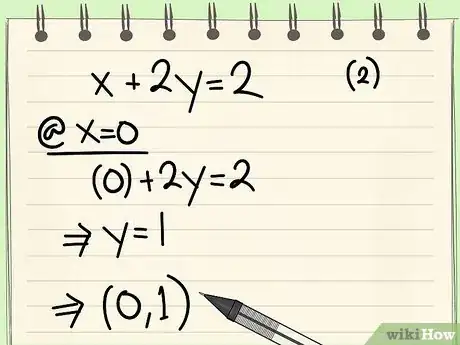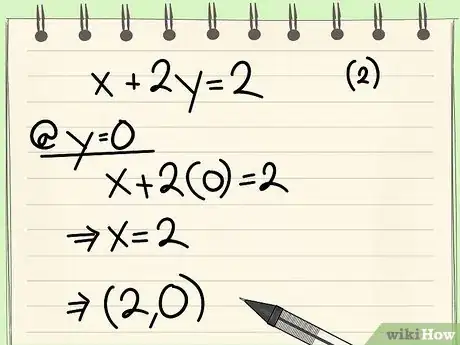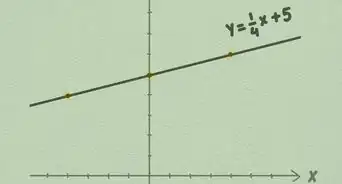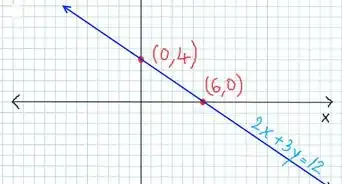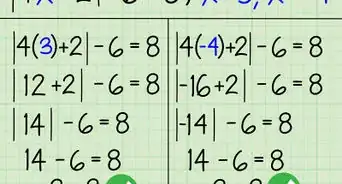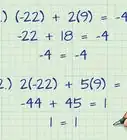X
wikiHow is a “wiki,” similar to Wikipedia, which means that many of our articles are co-written by multiple authors. To create this article, volunteer authors worked to edit and improve it over time.
This article has been viewed 101,038 times.
Learn more...
There are a few ways to solve simultaneous equations;[1] one of them is to plot the lines of the 2 equations, thus solving the equation. This article will teach you how to solve simultaneous equations graphically!
Steps
-
1Write your 2 equations clearly. Write your 2 equations in an organised, clear way. This will make it easier later.[2]
- In this guide, we are going to use equations 3x+4y=22 and x+2y=2 as an example.
-
2In the first equation, let x be 0. Replace x with 0, and solve the equation. This should give you the value of y.
- Using the example before: 3*0+4y=22, which becomes 4y=22, and then y=5½
- You now have your first coordinate, (0 ; 5½)
Advertisement -
3Let y be 0. In the first equation, let y be 0 and solve the equation. This will give you the value of x.
- Using the example: 3x+4*0=22 which becomes 3x=22 which gives us the answer of x=7⅓
- You now have a set of coordinates for your first line, (0 ; 5½) and (7⅓ ; 0)
-
4Draw a graph with 4 quadrants. Draw the line of your first equation on it.[3]
-
5In the second equation, let x be 0. Then solve the equation, giving you the value of y.
- Using the example, it's 0+2y=2, which becomes 2y=2 and y=1
- First coordinate is now (0 ; 1)
-
6Let y be 0. Solve the equation and get the value of x.
- Example: x+2*0=2, which becomes x=2.
- Second coordinate is now (2 ; 0)
-
7Draw the line of the second equation on the same graph as before. If needed, increase the length of the 2 lines until they meet.[4]
-
8Look at the point in which the 2 lines meet. Get it's coordinates (x ; y). The x coordinate will be the value of x in the equation, and the y coordinate will be the value of y![5]
- If you've been using the example, the lines should meet at point (18 ; -8). x will be 18, and y will be -8!
Advertisement
Community Q&A
-
QuestionWhat will be the answer if lines do not intersect?
 DonaganTop AnswererIf the graphed lines do not intersect, the system has no solution. That means there is no set of values for the variables that will work for both equations simultaneously.
DonaganTop AnswererIf the graphed lines do not intersect, the system has no solution. That means there is no set of values for the variables that will work for both equations simultaneously. -
QuestionHow do I guess the number, like x=0 or x=1, etc.?
 DonaganTop AnswererYou don't guess any numbers. You simply use a low number for x (like 0, 1, 2, -1, or -2, for example) so that it's easy to calculate the corresponding value of y.
DonaganTop AnswererYou don't guess any numbers. You simply use a low number for x (like 0, 1, 2, -1, or -2, for example) so that it's easy to calculate the corresponding value of y. -
QuestionHow do I solve y=2x+1, y=x-5?
 DonaganTop AnswererPlot both equations on the same graph. The x and y values of the point where the two lines intersect are the solution of the equations.
DonaganTop AnswererPlot both equations on the same graph. The x and y values of the point where the two lines intersect are the solution of the equations.
Advertisement
Warnings
- Sometimes you will need a very large graph⧼thumbs_response⧽
Advertisement
Things You'll Need
- Basic knowledge on How to Solve a Simple Linear Equation
- A ruler
- Pencil/Pen
References
- ↑ http://www.mathcentre.ac.uk/resources/Engineering%20maths%20first%20aid%20kit/latexsource%20and%20diagrams/2_13.pdf
- ↑ https://www.bbc.com/bitesize/guides/z9y9jty/revision/1
- ↑ https://www.mathplanet.com/education/pre-algebra/graphing-and-functions/solve-systems-of-equations-by-graphing
- ↑ https://www.mathplanet.com/education/pre-algebra/graphing-and-functions/solve-systems-of-equations-by-graphing
- ↑ https://math.libretexts.org/Bookshelves/Algebra/Book%3A_Elementary_Algebra_(OpenStax)/05%3A_Systems_of_Linear_Equations/5.01%3A_Solve_Systems_of_Equations_by_Graphing
About This Article
Advertisement




